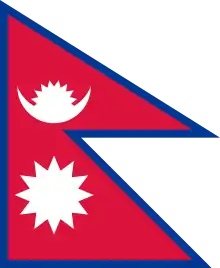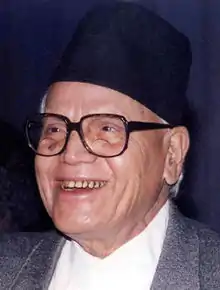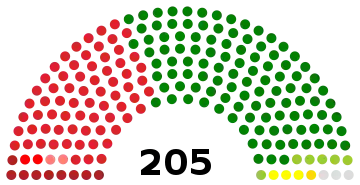1991 Nepalese general election
General elections were held in Nepal on 12 May 1991, to elect 205 members to the House of Representatives. The elections were the first multi-party elections since 1959. The 1990 Nepalese revolution successfully made King Birendra to restore a multi-party system after King Mahendra had established the Rastriya Panchayat when he dissolved the parliament on December 1960.[2][3]
 | |||||||||||||||||||||||||||||
| |||||||||||||||||||||||||||||
All 205 seats to the House of Representatives 103 seats were needed for a majority | |||||||||||||||||||||||||||||
|---|---|---|---|---|---|---|---|---|---|---|---|---|---|---|---|---|---|---|---|---|---|---|---|---|---|---|---|---|---|
| Turnout | 65.15%[1] | ||||||||||||||||||||||||||||
| |||||||||||||||||||||||||||||
| |||||||||||||||||||||||||||||
Results
| Party | Leader | Candidates | Votes | % | Seats | |
|---|---|---|---|---|---|---|
| Nepali Congress | Krishna Prasad Bhattarai | 204 | 2,742,452 | 37.75 | 110 | |
| CPN (Unified Marxist–Leninist) | Madan Bhandari | 177 | 2,040,102 | 27.98 | 69 | |
| Rashtriya Prajatantra Party (Chand) | Lokendra Bahadur Chand | 154 | 478,604 | 6.56 | 3 | |
| Rashtriya Prajatantra Party (Thapa) | Surya Bahadur Thapa | 163 | 392,499 | 5.38 | 1 | |
| Samyukta Janamorcha, Nepal | Baburam Bhattarai | 70 | 351,904 | 4.83 | 9 | |
| Nepal Sadbhavana Party | Gajendra Narayan Singh | 75 | 298,610 | 4.10 | 6 | |
| CPN (Democratic) | Bishnu Bahadur Manandhar | 75 | 177,323 | 2.43 | 2 | |
| Nepal Workers and Peasants Party | Narayan Man Bijukchhe | 30 | 91,335 | 1.25 | 2 | |
| Nepal Rastriya Janamukti Morcha | Malabar Singh Thapa | 50 | 34,509 | 0.47 | 0 | |
| CPN (Burma) | Krishna Raj Burma | 36 | 16,698 | 0.23 | 0 | |
| Janata Dal (Samajbadi Prajantantrik) | Keshar Jung Rayamjhi | 15 | 5,760 | 0.08 | 0 | |
| Nepal Rastriya Jana Party | 4 | 5,732 | 0.08 | 0 | ||
| CPN (Amatya) | Tulsi Lal Amatya | 14 | 4,846 | 0.07 | 0 | |
| Rastriya Janata Party | 9 | 4,280 | 0.06 | 0 | ||
| Nepal Conservative Party | 6 | 2,562 | 0.04 | 0 | ||
| Bahu Jana Janatadal | 1 | 2,012 | 0.03 | 0 | ||
| Ekata Party | 1 | 94 | 0.00 | 0 | ||
| Dalit Majdoor Kisan Party | 1 | 92 | 0.00 | 0 | ||
| Independents | 219 | 303,723 | 4.17 | 3 | ||
| Invalid votes | — | 322,023 | 4.42 | — | ||
| Total | 1345 | 7,291,084 | 100 | 205 | ||
Source: Election Commission of Nepal
Aftermath
Following the result of the election, Nepali Congress came to power and Girija Prasad Koirala became Prime Minister.[4] The house met for the first time on May 1991. Daman Nath Dhungana served as the Speaker of the House.[5] The parliament could not complete its full five-year term with Girija Prasad Koirala asking King Birendra to dissolve the house on July 1994 after losing a no-confidence motion with some member of his own party voting against him.[6][7]
References
- "Previous Election Facts and Figures". web.archive.org. 2008-10-21. Retrieved 2021-01-04.
- "Kingdom of Nepal: Parliamentary Elections, May 12, 1991". www.ifes.org. Retrieved 2020-12-12.
- Times, Special to The New York (1960-12-16). "NEPAL'S CABINET IS OUSTED BY KING; Mahendra Seizes Ministers as 'Anti-Nationalists' and Dissolves Parliament NEPAL'S CABINET IS OUSTED BY KING (Published 1960)". The New York Times. ISSN 0362-4331. Retrieved 2020-12-12.
- "Nepal Picks Prime Minister, In Transition to Democracy (Published 1991)". The New York Times. 1991-05-30. ISSN 0362-4331. Retrieved 2020-12-12.
- "Dhungana makes a comeback to politics after 23 years". kathmandupost.com. Retrieved 2020-12-12.
- "NEPAL: parliamentary elections Pratinidhi Sabha, 1994". archive.ipu.org. Retrieved 2020-12-12.
- Moore, Molly (1994-07-12). "NEPAL'S GOVERNMENT COLLAPSES AS KING DISSOLVES LEGISLATURE". Washington Post. ISSN 0190-8286. Retrieved 2020-12-12.


.jpg.webp)

